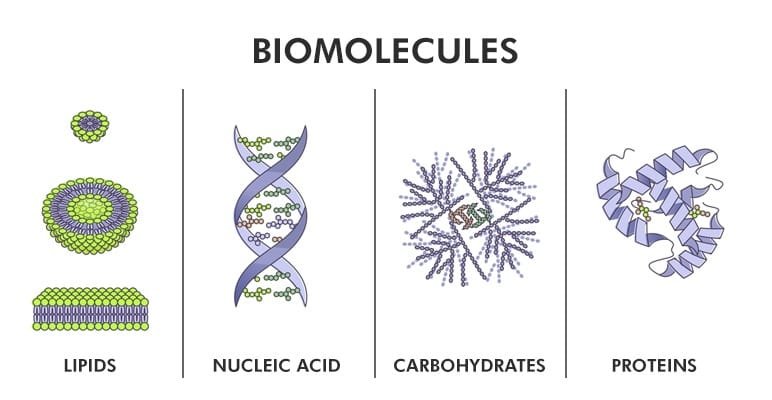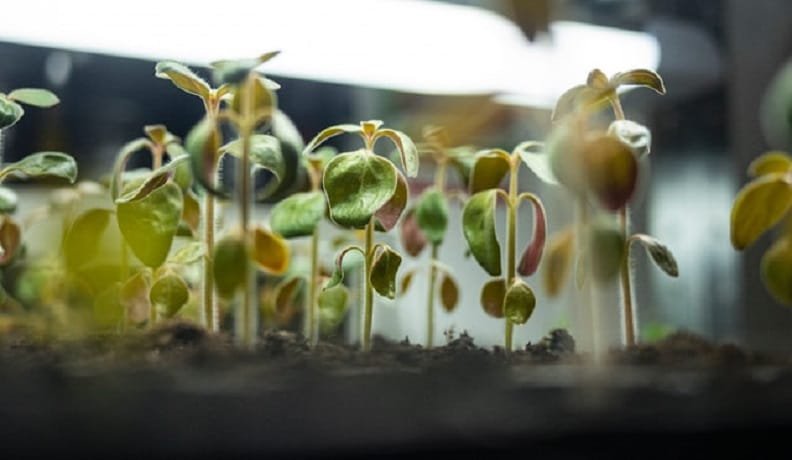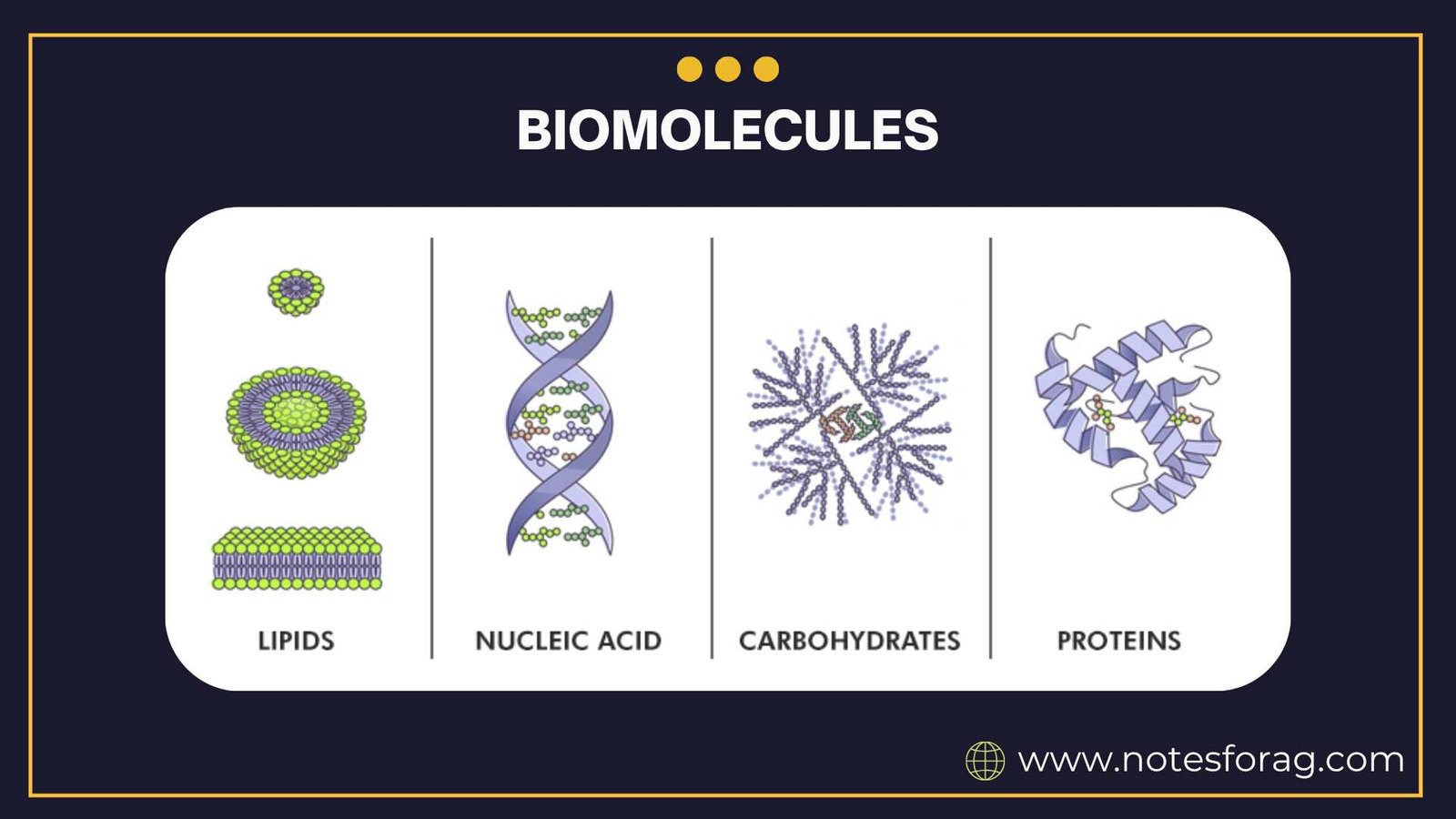INTRODUCTION

Biomolecules are essential organic compounds that make up living organisms and carry out various biological processes necessary for life. They include carbohydrates, proteins, lipids, nucleic acids, and other small molecules. These molecules are involved in forming cell structures, storing genetic information, supplying energy, and regulating metabolic processes. Studying biomolecules is fundamental in biology, biochemistry, and medicine, helping us understand life at the molecular level.
DEFINITION OF BIOMOLECULES
Biomolecules are naturally occurring chemical compounds found in living organisms. They are mainly composed of carbon, hydrogen, oxygen, nitrogen, phosphorus, and sulfur. These molecules interact in complex ways to support growth, development, and reproduction. Biomolecules are generally divided into four major classes: carbohydrates, proteins, lipids, and nucleic acids.
SUMMARY OF BIOMOLECULES
- Biomolecules like carbohydrates, proteins, lipids, and nucleic acids are essential for plant growth, structure, and reproduction.
- Plants also produce secondary metabolites, vitamins, enzymes, and hormones that help in defense, metabolism, and adaptation.
- Understanding plant biomolecules is crucial for advancing agriculture, biotechnology, and sustainable plant development.
Table of Contents
BIOMOLECULES IN PLANTS
1. Carbohydrates in Plants
Carbohydrates play a fundamental role in plants as the primary products of photosynthesis. Plants convert sunlight into chemical energy stored in the form of glucose through the process of photosynthesis. These glucose molecules are either used immediately to meet energy requirements or stored as complex carbohydrates like starch. Additionally, cellulose, a polysaccharide, forms the rigid structure of plant cell walls, giving plants their shape and strength. Carbohydrates in plants not only serve as energy sources but also support the transport of nutrients and water.
2. Proteins in Plants
Proteins in plants are crucial for their structure, metabolism, and defense mechanisms. Enzymes, which are protein molecules, catalyze biochemical reactions that regulate growth, respiration, and development. Structural proteins help in forming various plant tissues. Transport proteins assist in the movement of ions and nutrients across cell membranes. Furthermore, plants produce storage proteins in seeds, such as legumin and vicilin, which supply amino acids during germination. Some plant proteins also play a role in defending against pests and pathogens.
3. Lipids in Plants
Lipids in plants serve as important components of cell membranes, storage molecules, and signaling compounds. The phospholipids in plant cell membranes maintain structural integrity and regulate permeability. Triglycerides are stored in seeds and fruits as energy reserves, especially important during seed germination. Plants also synthesize a variety of waxes and cutin, which cover the surfaces of leaves and stems to prevent water loss. Certain lipids, such as jasmonates, act as signaling molecules in response to stress and injuries.
4. Nucleic Acids in Plants
Nucleic acids, including DNA and RNA, are responsible for storing and transferring genetic information in plant cells. DNA holds the instructions for building all cellular components and regulating their functions. RNA plays a central role in translating these instructions into proteins. During plant growth and reproduction, DNA replication and RNA transcription ensure that genetic information is passed on accurately. In plants, specific sequences of nucleic acids also control gene expression and developmental pathways.
5. Secondary Metabolites in Plants
Plants produce a wide array of secondary metabolites that are not directly involved in growth or reproduction but serve protective and ecological functions. These include alkaloids, flavonoids, terpenoids, and tannins. Alkaloids such as caffeine and nicotine deter herbivores. Flavonoids contribute to flower coloration and attract pollinators. Terpenoids have aromatic properties and play roles in plant defense. These compounds are also used in medicine, perfumes, and food industries due to their bioactive properties.
6. Vitamins in Plants
Plants synthesize various vitamins that function as coenzymes and antioxidants. Vitamin C (ascorbic acid) protects against oxidative stress, while vitamin A precursors like beta-carotene aid in photosynthesis and pigment formation. B vitamins support enzymatic reactions in plant metabolism. These vitamins are not only vital for the plant’s own health but also serve as essential nutrients for humans and animals who consume plant-based food.
7. Hormones in Plants

Plant hormones, or phytohormones, regulate physiological processes such as growth, flowering, fruiting, and stress responses. Major plant hormones include auxins, gibberellins, cytokinins, ethylene, and abscisic acid. Auxins promote cell elongation, while gibberellins stimulate stem growth and seed germination. Cytokinins aid in cell division, ethylene controls fruit ripening, and abscisic acid helps plants cope with water stress. Hormonal balance is critical for healthy plant development.
8. Enzymes in Plants

Enzymes in plants are vital for catalyzing chemical reactions involved in metabolism, defense, and signal transduction. They help in breaking down starch into sugars, synthesizing chlorophyll, and detoxifying harmful substances. For example, catalase breaks down hydrogen peroxide into water and oxygen, while amylase converts starch into glucose. These enzymes ensure that biochemical processes proceed efficiently under various environmental conditions.
CONCLUSION
Biomolecules in plants are essential for their survival, growth, reproduction, and adaptation. From carbohydrates fueling metabolic processes to proteins regulating enzymatic functions, and from lipids providing structural support to nucleic acids safeguarding genetic integrity, each biomolecule plays a critical role. Secondary metabolites, hormones, and enzymes further enhance a plant’s ability to thrive in diverse environments. Understanding biomolecules in plants not only deepens our knowledge of plant biology but also aids in agricultural innovation, biotechnology, and environmental sustainability.
Frequently Asked Questions (FAQs)
What are biomolecules in plants?
Biomolecules in plants are special chemical compounds that help the plant grow, stay healthy, and do all its life activities. These include carbohydrates, proteins, lipids, and nucleic acids. Each of these has a different job some give energy, some build parts of the plant, and others help in storing information or fighting off diseases.
Why are carbohydrates important for plants?
Carbohydrates are made during photosynthesis when plants use sunlight. These sugars give energy to the plant to grow and do its work. Some carbohydrates like starch are stored for later use, and others like cellulose make up strong parts like the plant’s cell wall, which gives shape and support.
What is the role of plant proteins?
Proteins in plants are like tiny workers. Some proteins called enzymes speed up chemical reactions that help the plant grow. Others help build plant parts like leaves and stems. Proteins in seeds store food, which helps young plants grow after germination. Some also help protect plants from insects and diseases.
How do lipids benefit plant cells?
Lipids are fats and oils that are very useful to plants. They are part of the cell membranes that control what goes in and out of the cells. Plants store lipids in seeds as a backup energy source. They also make waxy coverings on leaves and stems to stop water from escaping and keep the plant from drying out.
Related Articles

